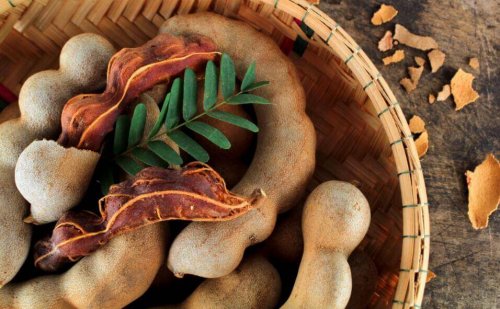Ways to Use Tamarind in Your Recipes


Written and verified by the nutritionist Eliana Delgado Villanueva
Tamarind is a tropical fruit from Africa. However, these days it’s also grown across Asia and America. In addition, it’s recently arrived and grown in popularity in Europe. The tamarind fruit is brown and belongs to the legume family.
Under its skin is has an acidic flesh that can get lightly sweet once ripe. It’s used in many recipes across the world, particularly in dressings and drinks.
Nutritional properties
According to data published in SELF Nutrition Data, among the main nutritional properties of tamarind is its high carbohydrate content. In addition to its many nutritional properties, it also contains vegetable proteins, made up of various amino acids, such as tryptophan, methionine, and lysine.]
Additionally, it provides soluble fibers, such as pectin, and vitamins A, B3, and C. Tamarind also contains beneficial minerals such as magnesium, calcium, potassium, iron, and phosphorous.
Lastly, as corroborated by a study published in Pharmacognosy Reviews, tamarind has low-fat content and works as a laxative, antioxidant, antimicrobial, and antidiabetic, among others.
Learn about the Incredible Benefits of Turmeric Juice
Tamarind water recipe

This drink is used a lot in Mexican cooking and has detox effects on the body. It’s a delicious drink and has a nice bite due to the Tamarind’s acidic flavor.
The use of sugar or stevia also provides a sweetness so that everybody can enjoy it. Of course, avoid sugar if your nutritionist suggests it.
Ingredients
- 1/4 c. of brown sugar or stevia
- 1 c. of dry tamarind
- 2 qt. of water
Preparation
- First, you need to peel the fruit to remove the skin from the pods
- Once peeled, put the tamarind pods in boiling water so that they soften and begin to loosen the flesh
- Once the tamarind has been boiling for 15 to 20 minutes, remove the remains of the pods and leave the water to cool
- While it’s cooling, take a pestle and mortar to the softened pods and crush them to get all the pulp out
- This way it will be easy to remove the husks. Once removed, drop the pulp in the water and stir well.
- Finally, put the water and tamarind into a blender. Add the sugar and the remaining water.
- Process well until you get a nice mixture.
- Voilá! You’ve just made some tamarind water which you can serve with ice. You can add more water or sugar to suit your taste.
Tamarind sauce recipe

Another fun way to prepare tamarind at home is a sauce that goes really well with chicken or calamari dishes. It’s very easy to make.
Ingredients
- 1 clove of garlic
- 1 chipotle pepper
- 1/4 red onion
- 1 tbsp. of sugar
- A pinch of salt and pepper
- 2 tbsp. of olive oil
- 2 c. of tamarind pulp
Note: You can buy tamarind pulp already prepared in a jar. However, if you want to prepare it at home, which always makes a recipe a little more special, then simply follow the same instructions as for the tamarind water.
Preparation
- Begin by peeling the tamarind and putting the pods in some boiling water
- Remove the softened pods after 15 minutes and remove the pulp from the husks
- Then, heat the olive oil
- Add the garlic, chopped red onion, and the tamarind pulp
- After a few minutes, the pulp will have softened. Lower the heat to a minimum and add the crudely chopped chipotle chile and a pinch of salt and pepper.
- Once all the ingredients have softened, put them all in a blender
- Process the mixture well until you get a well-blended sauce
- Finally, leave it to cool so that it thickens before use
So, do you want to try these simple tamarind recipes? As you can see, it’s a nutritious food you can take advantage of in your kitchen. Get it and enjoy its unique flavor.
All cited sources were thoroughly reviewed by our team to ensure their quality, reliability, currency, and validity. The bibliography of this article was considered reliable and of academic or scientific accuracy.
- Bhadoriya SS, Ganeshpurkar A, Narwaria J, Rai G, Jain AP. Tamarindus indica: Extent of explored potential. Pharmacogn Rev. 2011;5(9):73–81. doi:10.4103/0973-7847.79102
- Sandesh P, Velu V, Singh RP. Antioxidant activities of tamarind (Tamarindus Indica) seed coat extracts using in vitro and in vivo models. J Food Sci Technol. 2014;51(9):1965–1973. doi:10.1007/s13197-013-1210-9
- Okello J, Okullo JBL, Eilu G, Nyeko P, Obua J. Physicochemical composition of Tamarindus indica L. (Tamarind) in the agro-ecological zones of Uganda. Food Sci Nutr. 2018;6(5):1179–1189. Published 2018 Apr 16. doi:10.1002/fsn3.627
This text is provided for informational purposes only and does not replace consultation with a professional. If in doubt, consult your specialist.








